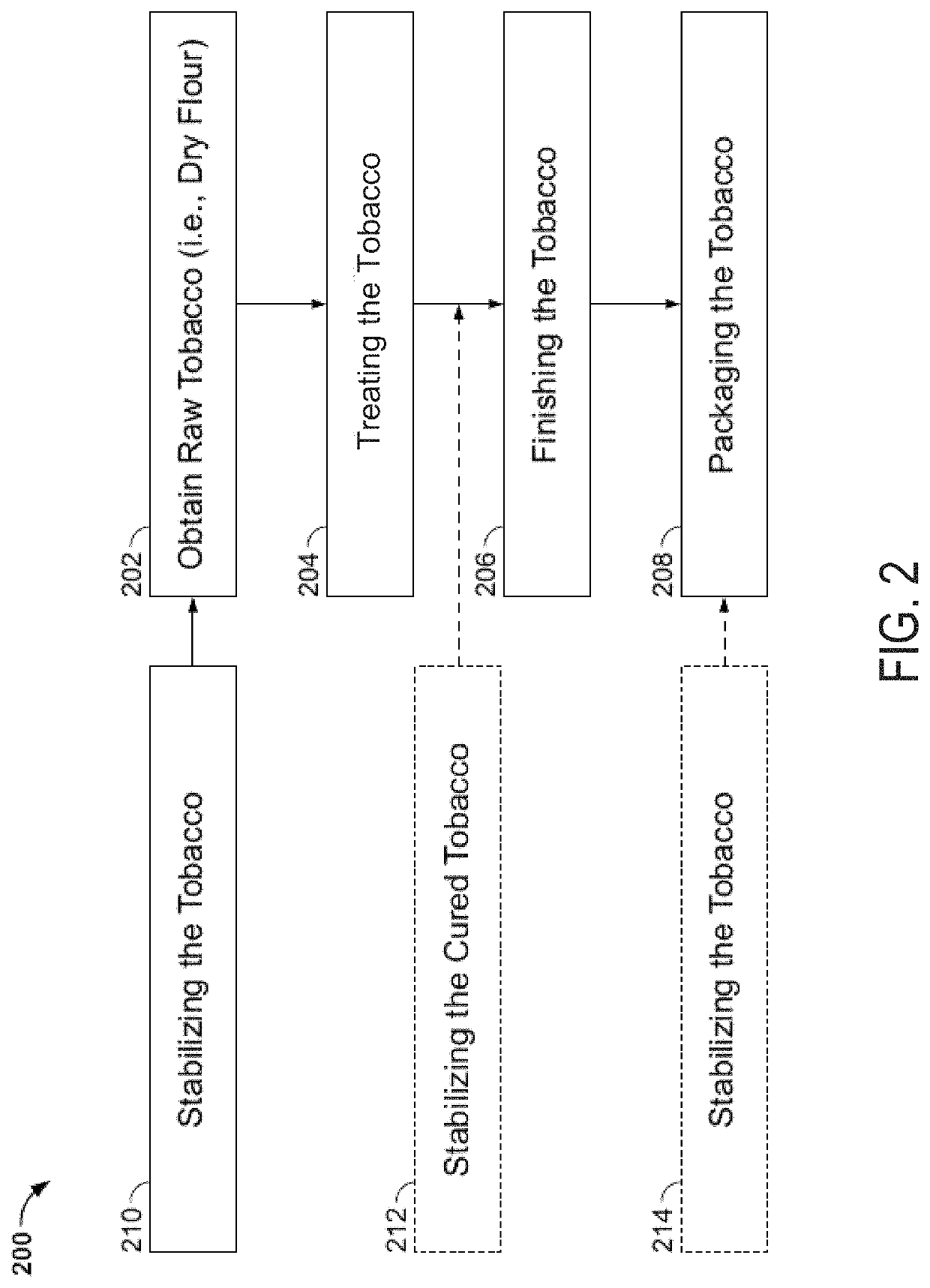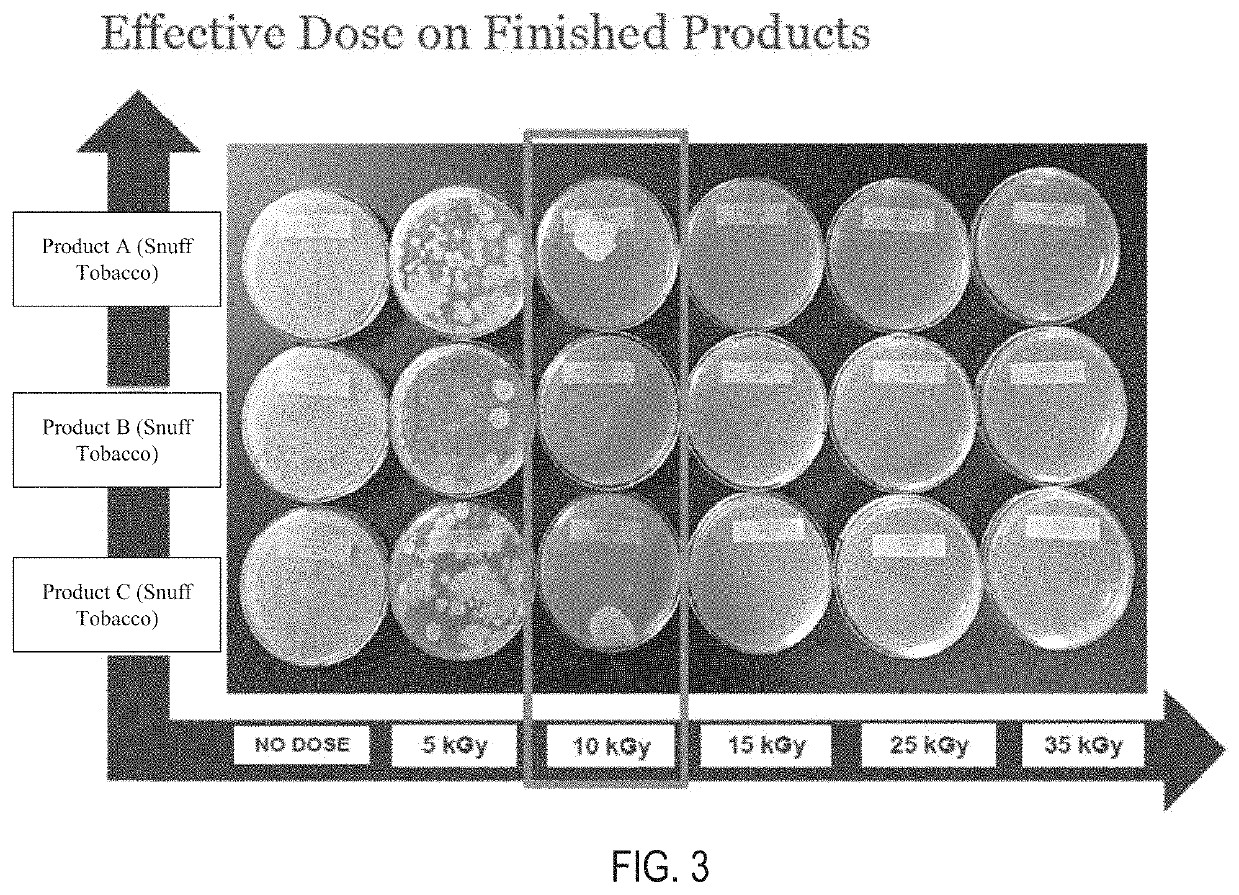Stabilization methods for tobacco and tobacco products
a technology of stabilization method and tobacco, which is applied in the field of stabilization method of tobacco and tobacco products, can solve the problems of insect resistance to the sterilization process described herein, significant loss of tobacco leaves stored, and the effect of reducing the risk of infection
- Summary
- Abstract
- Description
- Claims
- Application Information
AI Technical Summary
Benefits of technology
Problems solved by technology
Method used
Image
Examples
example 1
[0098]Three exemplary finished tobacco products having a pH=7.8 and oven volatiles ranging from about 55.8 to about 57.1% were subjected to different dosage intensities using the E-Beam treatment as described herein, and microbiologically tested. The tobacco products included Product A (Snuff Tobacco), Product B (Long-Cut Tobacco), and Product C (Long-cut Tobacco). Samples from each of the three products were stabilized using six different E-Beam dosage conditions, including 1) 0 kGy (i.e., a “no dose” condition); 2) 5 kGy; 3) 10 kGy; 4) 15 kGy; 5) 25 kGy; and 6) 35 kGy.
[0099]A set of test group samples included the three different products, each stabilized with the E-Beam treatment at the various treatment dosages of 5 kGy, 10 kGy, 15 kGy, 25 kGy, and 35 kGy for approximately 2-3 seconds. The test group was E-Beam sterilized with an IMPELA E-Beam accelerator at about 5-10 MeV, and 60 kW (supplied by Iotron Industries, Columbia City, Ind.).
[0100]A control group (identified in FIG. 3...
example 2
[0105]Different exemplary forms of dried raw (unfermented) tobacco were subjected to the E-Beam treatment described herein and tested microbiologically. Three different tobacco forms, which included Sample A (fine-cut, dried raw tobacco), Sample B (long-cut, dried raw tobacco), Sample C (undried, moist raw tobacco), having a pH of about 5.15, about 5.12, and about 5.38, and oven volatiles of about 5.31, about 4.97, and about 23.01%, respectively, were evaluated.
[0106]The test group, which included three different forms of tobacco, was subjected to the E-Beam treatment at various treatment dosages (10 kGy and 15 kGy) for approximately 2-3 seconds. The test group was E-Beam sterilized with an IMPELA E-Beam accelerator at 5-10 MeV, and 60 kW (supplied by Iotron Industries, Columbia City, Ind.).
[0107]A control group (identified in FIG. 4 as the “no dose” group), which included a sample of each of the three forms of tobacco, was not subjected to the E-Beam treatment.
[0108]The control gro...
example 3
[0112]Exemplary fine-cut, dried raw (unfermented) tobaccos having a pH of about 5.15 and oven volatiles of about 5.31% conditioned with different oven volatiles contents (i.e., amounts of moisture) were subjected to different E-Beam treatment dosage levels and microbiologically tested.
[0113]Test and control samples of the tobacco were conditioned using methods discussed herein to achieve the moisture oven volatile content of 5, 15, and 25% by weight before being subjected to the E-Beam treatment.
[0114]The conditioned test samples of the tobacco were subjected to the E-Beam treatment at various treatment dosages (10 kGy and 15 kGy) for approximately 2-3 seconds. The test group was E-Beam-sterilized with an IMPELA E-Beam accelerator at 5 MeV (supplied by Iotron Industries, Columbia City, Ind.).
[0115]A control group (identified in FIG. 4 as the “no dose” group), which also included samples of the different conditioned tobaccos, was not subjected to the E-Beam treatment.
[0116]The contro...
PUM
 Login to View More
Login to View More Abstract
Description
Claims
Application Information
 Login to View More
Login to View More - R&D
- Intellectual Property
- Life Sciences
- Materials
- Tech Scout
- Unparalleled Data Quality
- Higher Quality Content
- 60% Fewer Hallucinations
Browse by: Latest US Patents, China's latest patents, Technical Efficacy Thesaurus, Application Domain, Technology Topic, Popular Technical Reports.
© 2025 PatSnap. All rights reserved.Legal|Privacy policy|Modern Slavery Act Transparency Statement|Sitemap|About US| Contact US: help@patsnap.com



